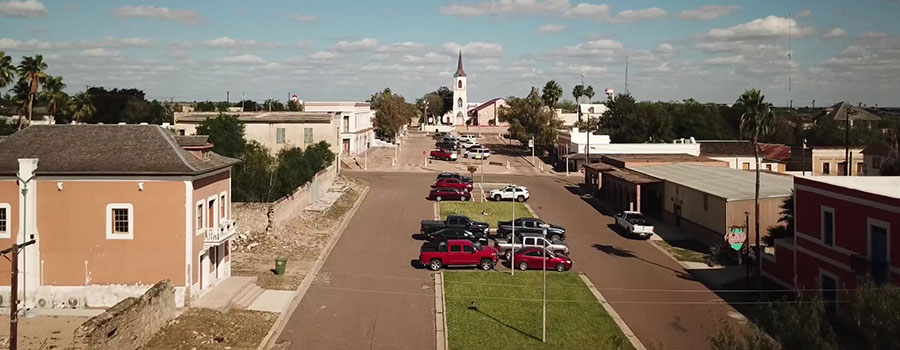Roma, Texas

Located along the Rio Grande River in Starr County, Texas
Established: 1765
Architect Style: The 19th-century architecture in the Roma Historical District consists of buildings made of river sandstone, caliche limestone and molded brick.
Show Description:
High above the Rio Grande, a stone’s throw from Mexico, Roma is a stunning example of late 19th architecture that combines European elegance with borderland style. Many of the historic buildings bear the craftmanship of Heinrich Portscheller, like the M. Guerra building–considered the crown jewel of the district. Efforts to preserve the historic structures have been ongoing.
Other Structures designed by Heinrich Portscheller:
- Silverio de la Peña Building Ca. 1886
1886. 424 E. Main Street, Rio Grande City, TXThis two-story brick building was originally the home and business of the city’s postmaster and pharmacist and is located in the center of the Rio Grande City Downtown Historic District. It’s a corner property that features a side courtyard, a two-story arched gallery and columns at each corner. The letters “S.P.” and the year “1886” are pressed into square-shaped brick.
- Jose Nestor Sáenz Store, Ca 1884
SE Corner of Hidalgo and Juarez Streets, Roma, TXThe one-story brick, L-shaped commercial building features multiple bays with doors and like Portscheller’s other structures, the molded brickwork features prominently. “Nestor Saenz” is spelled in molded brick just below the roofline. The building is situated on a slope just below Juarez Street. This was done so the store would have direct access to the wharf area where steamboats delivered goods.
- Pablo Ramírez House, Ca 1884
901 Estrella Street, Roma, TXThe two-story sandstone structure was originally built as a family home. The house features an angled corner entrance and a wraparound balcony on the second floor. In the back, the two-story arched gallery overlooks a walled courtyard.
More architecturally significant border towns to explore in Texas:
- El Paso, Texas
The city of El Paso runs the gamut with architectural styles. From early adobe structures, turn of the century neoclassical buildings, art deco from the 20s and 30s and mid-century modern.
- Brownsville, Texas
The Brownsville Historic Association offers several walking tours of Downtown and the Market Square. Check out The Gem/La Hoya building on 13th Street, it’s of the oldest commercial brick buildings in Brownsville. and is an excellent example of Spanish Colonial style. And don’t miss the U.S. Federal Building on E. Elizabeth Street. It was originally built in 1892 but was reconstructed in 1931 to reflect an Italian Revival style.
- Laredo, Texas
Part of the National Register of Historic Places since 1973, the architecture in San Agustin de Laredo Historic District reflects Spanish and Mexican influences and is considered the last example of Spanish Colonization in the Lower Rio Grande Valley.









